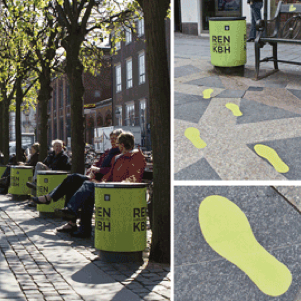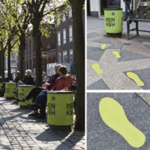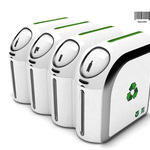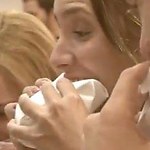This section explores innovative technologies and inspirational initiatives in the waste management domain which could, one day, be implemented in Texel. We shall also identify groups that need further consideration to steer the TX sub system in the desired direction.
3.4.1 Innovative technologies that could make its way to texel
- Biodegradable packaging
”Biodegradable plastics” or “Environmentally degradable plastics” is an umbrella term that encompasses:(Nolan-ITU Pty Ltd, ExcelPlas Australia, 2002)
1. Biodegradable plastics.
2. Compostable plastics.
3. Hydro-biodegradable plastics.
4. Photo-biodegradable plastics.
5. Bio-erodable plastics.
The American Society of the International Association for Testing and Materials (ASTM) defines Biodegradable plastics as (Nolan-ITU Pty Ltd, ExcelPlas Australia, 2002):
“plastics capable of undergoing decomposition into carbon dioxide, methane, water, inorganic compounds, or biomass in which the predominant mechanism is the enzymatic action of microorganisms, that can be measured by standardized tests, in a specified period of time, reflecting available disposal condition”(ASTM Standard D-5488-84d)
The ASTM defines compostable plastics as (Nolan-ITU Pty Ltd, ExcelPlas Australia, 2002):
“plastics capable of undergoing biological decomposition in a compost site as part of an available program, such that the plastic is not visually distinguishable and breaks down to carbon dioxide, water, inorganic compounds, and biomass, at a rate consistent with known compostable materials (e.g. cellulose)."
The four major markets for biodegradable materials are supposed to be (Nayak, 1999)
• Food packaging.
• Non-food packaging.
• Personal and health-care disposal.
• Consumer goods.
Advancement in Biopackaging technology has led to development of products like MONODOSETM(www.monosol.com)- water soluble pouches for detergents, agrochemicals, insecticides, AQUAFILM®(www.monosol.com) -dissolvable laundry bags and flushable liners and bags and medical delivery systems and devices(David & Song,2006).
- Edible packaging
Edible films & coatings are biodegradable packaging derived from edible biopolymers and food grade additives (polysaccharides, proteins).The application of edible films and coatings can, apart from protecting food from spoilage, immediately improve the physical strength of food products, reduce particle clustering, and better visual and tactile features on product surface. Edible films also have non-food uses: surface coating of low grade papers with edible biopolymers improves quality for printing etc. (Han, Gennadios, 2005).
Companies like MONOSOL®(www.monosol.com) are at the forefront of application of edible films with products like VIVOTM water soluble films, designed to deliver definite portions of food products that are used in hot/cold water (tea addition of colours, flavours during manufacture). The company claims that the product leaves no smell or taste when consumed. The Brazilian fast food chain, BOB’S(www.bobs.com.br), served up burgers in edible packaging as part of a marketing campaign designed to create an impression that the burgers are so good, clients can’t wait to unwrap them, eventually leading to lesser landfill waste(Tepper,2012),. WikipearlTM (www.wikipearl.com) is another pioneer in edible film applications. Such solutions effectively obviate the need for primary package throwaway.
Figure 3.x A clip from BOB’s edible wrapping Campaign.(Tepper, 2012)
- Barcode scanner bins
Recyclables feature a number value in their barcodes that denotes its material type and whether it can or cannot be recycled.When you scan the product you are throwing away on the bin scanner, these bins read that number and the corresponding can (paper, bottles,plastic) opens for your convenience (see figure 3.x)( Fallon,2008).
Figure 3.x Barcode scanner Bins
3.4.2 Inspiring Initiatives that could make its way to texel
- Footprints
Texel has a real problem with littering on its beaches.Locating a garbage can immediately is not always the easiest of tasks,especially if you are a tourist. This issue could be solved if the locals and the tourists could be nudged to find the nearest trash bin. An inspirational venture in this direction is the “green footprints” project launched by the municipality of copenhagen in collaboration with the university of roskilde on 2012. The project involved installing 1500 trash bins around the city with green footprints stickers that lead to them (see figure 3.x) . Not only was the green footprints nudge effective, it was also a great example of subtly nudging people into not littering. The project was then replicated in the English town of sutton (inudgeyou.com,2012;Chad, 2014.)
Figure 3.x Footprints in copenhagen (inudgeyou.com,2012)
- Pay-As-You-Throw Programs
Pay-As-You-Throw or PAYT programs charge households for solid waste based on the amount of waste that they generate. The more solid waste the houses generate, the more they pay. The objective is to create a financial incentive for residents to recycle, thus decreasing the amount of waste sent to landfills and incinerators. In the city of Austin in the USA for instance, households are provided with a smaller green bin for regular waste and a larger blue bin for recyclables.Residents are urged to recycle more through the city’s single-stream recycling program (blue bin) and pay for the smallest garbage bin that will accommodate their weekly waste. The prices charged of the smaller green bins increase proportionally with size (nudges.org,2011).
- Recycle Bank
RecycleBank is an initiative in New York city, USA that aims to encourage people to recycle more and decrease landfill waste by granting points for recycling, saving energy, and answering sustainability quizzes and pledges. Points are exchangeable for products at consumer outlets such as WalMart, BestBuy and more places, as the city government reimburses RecycleBank for bringing down landfill waste. The project has won numerous awards in innovation, sustainability, and business. It now has 3 Million members and over 180 employees pushing the recycling envelope further (Recyclebank.com,2015).
3.4.3 Relevant Groups
Now that we have seen some technologies and projects that can be implemented in Texel, we should investigate which actors play a role in possible execution. The first actor is the municipality of Texel and the Dutch government.. The municipality and the government have the financial and knowledge network resources that can bring these plans to fruition. Governmental agencies and public bodies can act as intermediaries that have experiences in other cases similar to that of Texel’s waste management problem. These actors can encourage the community in Texel with anecdotes of and lessons from those cases. Also, these bodies can broker deals with private firms that are interested in operating in Texel. The second actor are the waste management companies that currently operate in texel. These actors can introduce new technology and new business models that are based on “gamification”. These actors can also act as intermediaries since these actors operate elsewhere as well and may have had experiences to that of Texel. The last actor that plays a crucial role are the Tesselaars themselves. The local community can start off one of the ideas described above or something similar as a local, grassroot initiative. However, they will need the assistance of intermediaries such as the municipality or private companies.
References
- inudgeyou.com, (2012), Green nudge: Nudging litter into the bin,http://inudgeyou.com/green-nudge-nudging-litter-into-the-bin/, 02/12/2015
- Chad.co.uk,(2014), Scheme aims to cut littering in Ashfield, http://www.chad.co.uk/news/local/scheme-aims-to-cut-littering-in-ashfield-1-6698879, 02/12/2015
- Fallon, S., Barcode Scanner Bins Make Recycling Fun For Nerds, http://gizmodo.com/356705/barcode-scanner-bins-make-recycling-fun-for-nerds, 02/12/2015
-
nudges.org, (2011),A strategy for recycling: Change the recycling-bin-to-garbage-bin ratio,http://nudges.org/2011/05/02/a-strategy-for-recycling-change-the-recyling-bin-to-garbage-bin-ratio/, 02/12/2015
- Recyclebank.com, (2015),About Us,https://www.recyclebank.com/about-us, 02/12/2015
- Nolan-ITU Pty Ltd and ExcelPlas Australia, 2002, Biodegradable Plastics - Developments and Environmental Impacts, Australia Department of Environment and Water Resources.
- Nayak, P., (1999), Biodegradable polymers: opportunities and challenges. Rev. Macromol. Chem. Phys. C39, 481–505.
- Davis G., Song,J.H., (2006), Biodegradable packaging based on raw materials from crops and their impact on waste management, Industrial Crops and Products 23, Bristol &Middlesex.,147-161.
- Han, J.H., Gennadios A., (2005), Edible films and coatings: a review, Edible and biodegradable coatings and films,Innovations in food packaging, Academic press.239-262.
- Tepper,R., (2012), Bob's Burger Chain Features Edible Packaging, http://www.huffingtonpost.com/2012/12/19/edible-packaging_n_2330022.html, 02/12/2015



